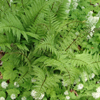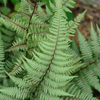





Plant Calculator
Enter the approximate length and width of the area you will be planting and click 'Calculate' to determine how many Athyrium filix-femina 'Victoriae' you will need.
Correct and successful spacing is complex and depends on project conditions. We encourage you to call us at 877-ECO-PLUG for project specific recommendations and further assistance.
Athyrium filix-femina 'Victoriae'
lady fern
- Category: Fern, Native
- Hardiness Zone: 4-8
- Height: 18-24 Inches
- Spread: 20-24 Inches
- Spacing: 12 Inches
"This is the most spectacular of all cultivars in its magnificent frond architecture. It is really the Queen of Green", according to Dr. John Mickel, former curator of ferns at the New York Botanical Garden and author of "Ferns for American Gardens". As with other forms of lady ferns there is so much variability with spore production that it is necessary to produce this form in tissue culture, so its clones are identical to the parent. This superb selection has fronds whose pinnae (leaflets) crisscross to form x's and has crested pinnae tips. Another superior cultivar in the Mickel Collection™.
Click here to download technical information for growers:
Soil Moisture Needs
| • | Moist |
Green Infrastructure
| • | Woodland |
Wetland Indicator Status
| • | Falcutative (FAC) |
Plug Type
| • | Landscape Plug™ |
For Animals
| • | Deer Resistant |
Propagation Type
| • | Tissue culture |
Additional Information about Athyrium filix-femina 'Victoriae'
Athyrium filix-femina ‘Victoriae’ grows in clumps of lacy filigreed foliage 24” tall. Discovered in Scotland in 1861 during the Victorian Fern Craze, this unusual selection’s pinnae criss-cross and form an ‘X’ pattern. Tips of the ferns are crested and create drooping fringes. The fronds are distinct and unusual, a sure attention grabber in a garden or a container.
Lady fern flourishes in bright shade and moist, rich, organic soil. Athyrium filix-femina is circumglobal and can be found in rich moist woods, thickets, fields, meadows, and ravines throughout North America. While it does tolerate wet feet, it does not tolerate clay. Athyrium tolerates sun if kept cool and consistently moist. To maintain verdant appearance, protect from harsh winds, but provide adequate air circulation. To propagate, divide lady fern clumps every few years in the spring. Unlike other ferns, lady fern is relatively tolerant of sun and dry soil as compared to many other ferns. They spread nicely but don't run.
Like most ferns, Athyrium are deer resistant. It is a very low maintenance plant that adds aesthetic value to the landscape. The fronds of these ferns provide nesting habitat for wildlife.
Growing & Maintenance Tips for Athyrium filix-femina 'Victoriae'
Lady ferns have reliable color and are easy to grow. Best growth will occur in partial shade and a rich, moist soil. Relatively tolerant of sun and dry soil as compared to many other ferns. They spread nicely but don't run. A very low maintenance plant that adds a lot of aesthetic value to the landscape. Propagate by clump division in early spring or by spore.


